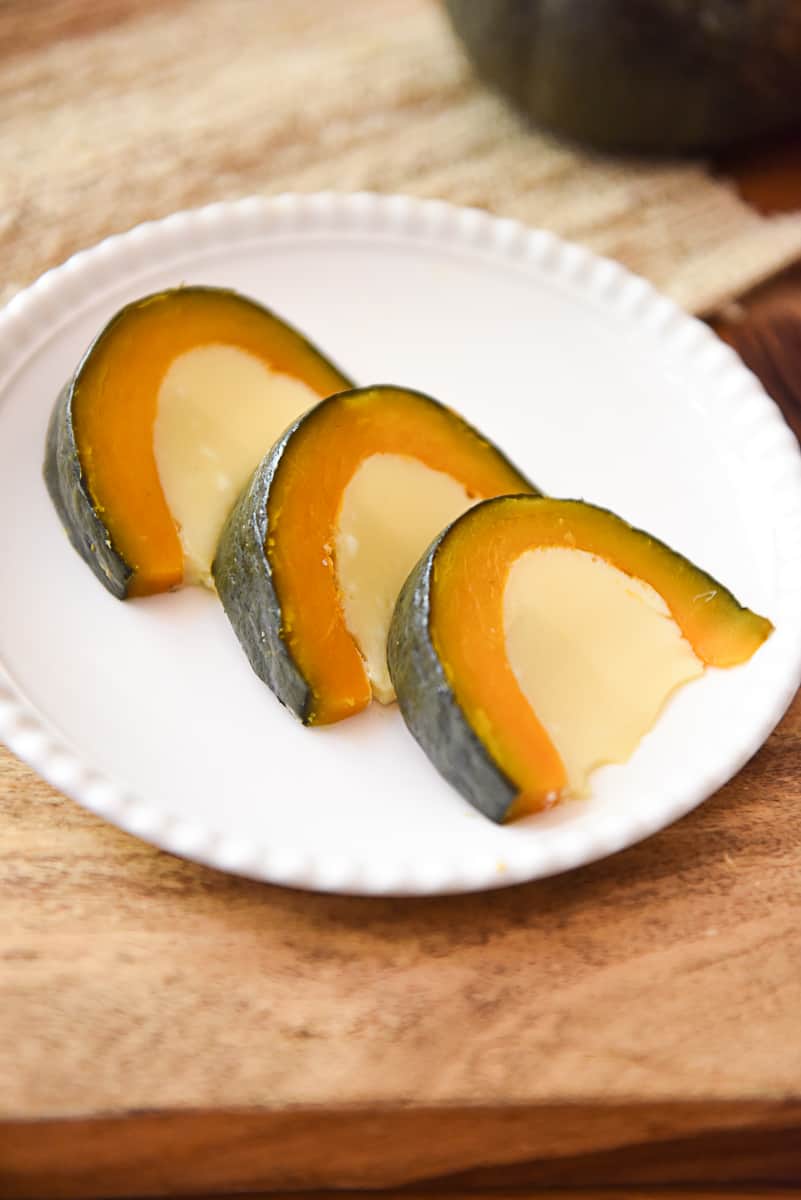
This Thai pumpkin custard is one of my favorite desserts to serve in the Fall. A rich, creamy coconut custard is steamed right inside a whole pumpkin, making for a stunning presentation after a Thai meal.
It is a perfect dessert for those of us, like me, who love pumpkin desserts in all shapes and forms. And its intriguing presentation may even win over people like my husband, who are not innate pumpkin fans.
Jump to:
What is Thai Pumpkin Custard?
This Thai pumpkin custard is known as Sankaya Faktong. In Thai, sankaya means custard, and faktong means pumpkin. The custard is made with egg, coconut milk, and palm sugar. It is poured into a pumpkin, and then steamed until the custard is firm and the pumpkin is perfectly cooked. The custard itself is quite sweet, but the sweetness is balanced out when eaten with the steamed pumpkin.
Sankaya Faktong is one of several coconut custard desserts in Thailand. Another version of this dessert is served inside of a hollowed out coconut shell, and another variation is to serve the custard on top of a bed of sweetened sticky rice. Other variations include jackfruit, durian, or other ingredients mixed in the custard itself.
Ingredients
- Kabocha squash: This pumpkin most closely mimics the pumpkins that are usually used in Thailand. For this dessert, the smaller the kabocha squash, the better!
- Eggs: Four medium sized chicken eggs work well in this recipe. Duck eggs are often used in Thailand.
- Coconut milk: Coconut cream or thick coconut milk is best. This recipe relies on canned coconut milk, as it is usually thicker than hand-squeezed coconut milk. Be sure to mix the can before using.
- Palm sugar: Palm sugar provides sweetness to this custard. You can experiment with other sweeteners, but you will loose the characteristic palm sugar flavor.
- Salt: Salt is used so that the custard isn't just one-dimensionally sweet.
- Vanilla: This recipe calls for vanilla to give the custard another flavor note. In Thailand, pandan would be more commonly used.
Instructions
For its stunning presentation, Thai pumpkin custard is actually fairly straightforward to make. You simply make the custard, pour it inside a hollowed out pumpkin, and steam them both together. When it's done, the custard will have set firmly inside the pumpkin and the pumpkin itself will be perfectly tender.
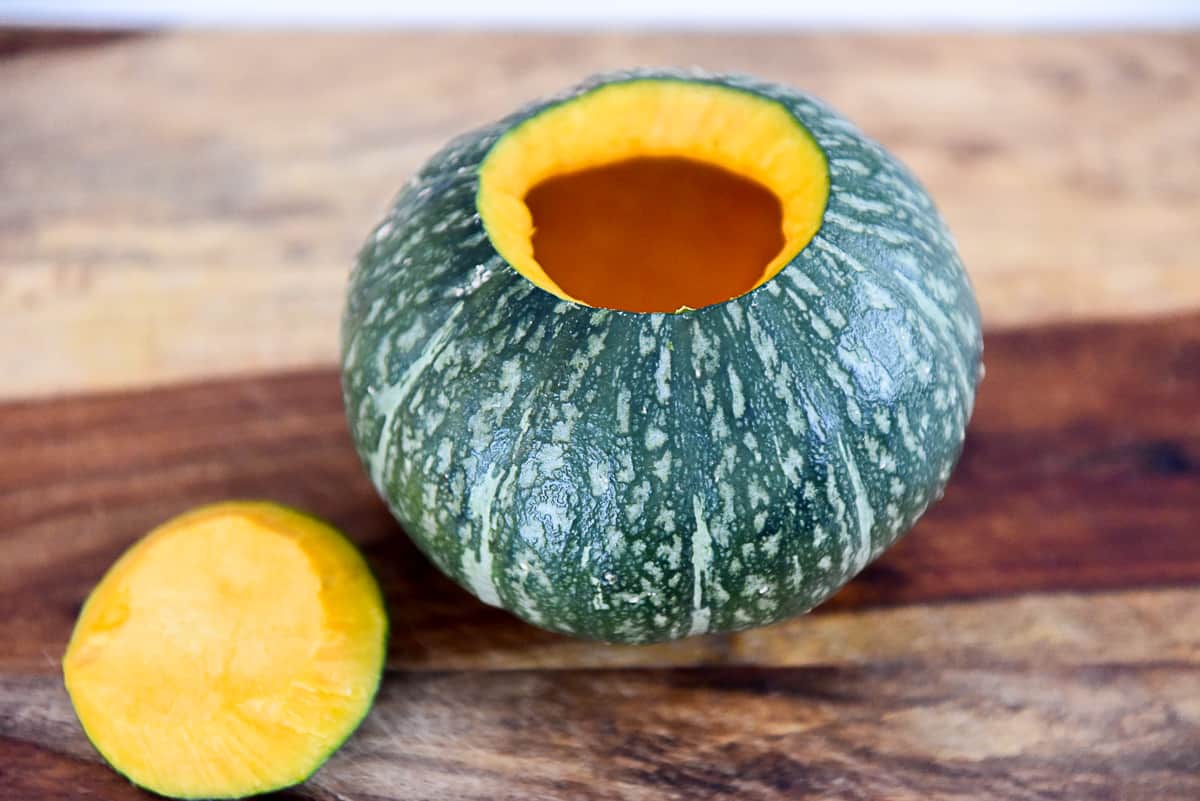
Wash the outside of your pumpkin. Then cut a circular hole in top, scoop out its insides, rinse and dry it well.
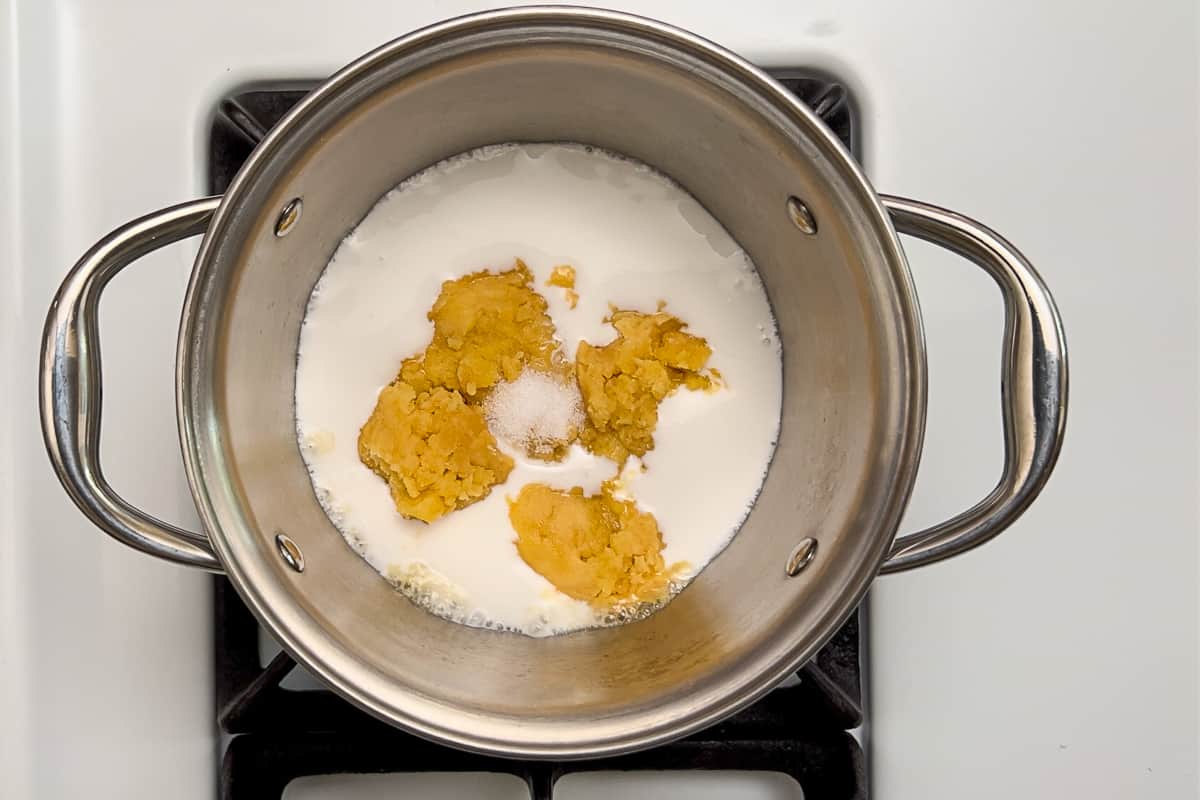
Mix the palm sugar, coconut milk, salt, and vanilla extract over medium heat. Once cooled, add the eggs and mix well.
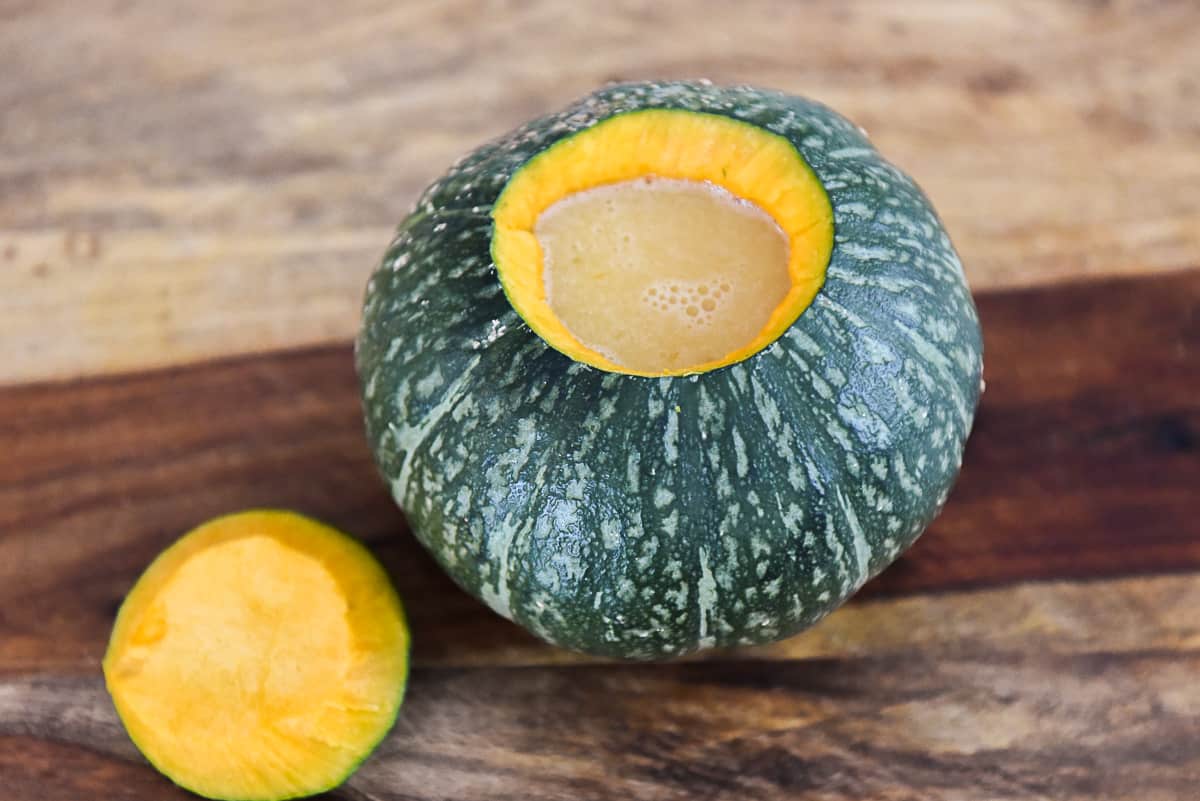
Pour the custard into your hollowed out pumpkin, just to the bottom of the circular opening.

Steam the custard-filled pumpkin for 45 minutes in the top of a steamer pot over medium high heat. Cool and slice.
Which Pumpkin is Best for Thai Pumpkin Custard?
Kabocha squash most closely mimics the Thai pumpkin that is used to make this dessert. It has a hard green outer shell that can be challenging to cut through, but once you do, you're rewarded with a smooth, delicate orange flesh. Kabocha squashes come in various sizes, but I've found for this recipe, the smaller ones are better. Choose a pumpkin that can fit into the palm of your hand.
Tips to Prevent Custard from Splitting / Not Setting
- Use thick coconut milk: Thicker coconut milk, or even coconut cream, can help to prevent the custard from splitting or not setting against the pumpkin walls.
- Steam over lower heat: In Thailand, this custard is often steamed over high heat. If you run into issues with the custard splitting, you can try steaming it at a lower heat for longer.
- Ensure the pumpkin is dry: After cleaning and washing the pumpkin, you should allow it to drip dry completely. Any moisture left may prevent the custard from setting properly against the pumpkin walls.
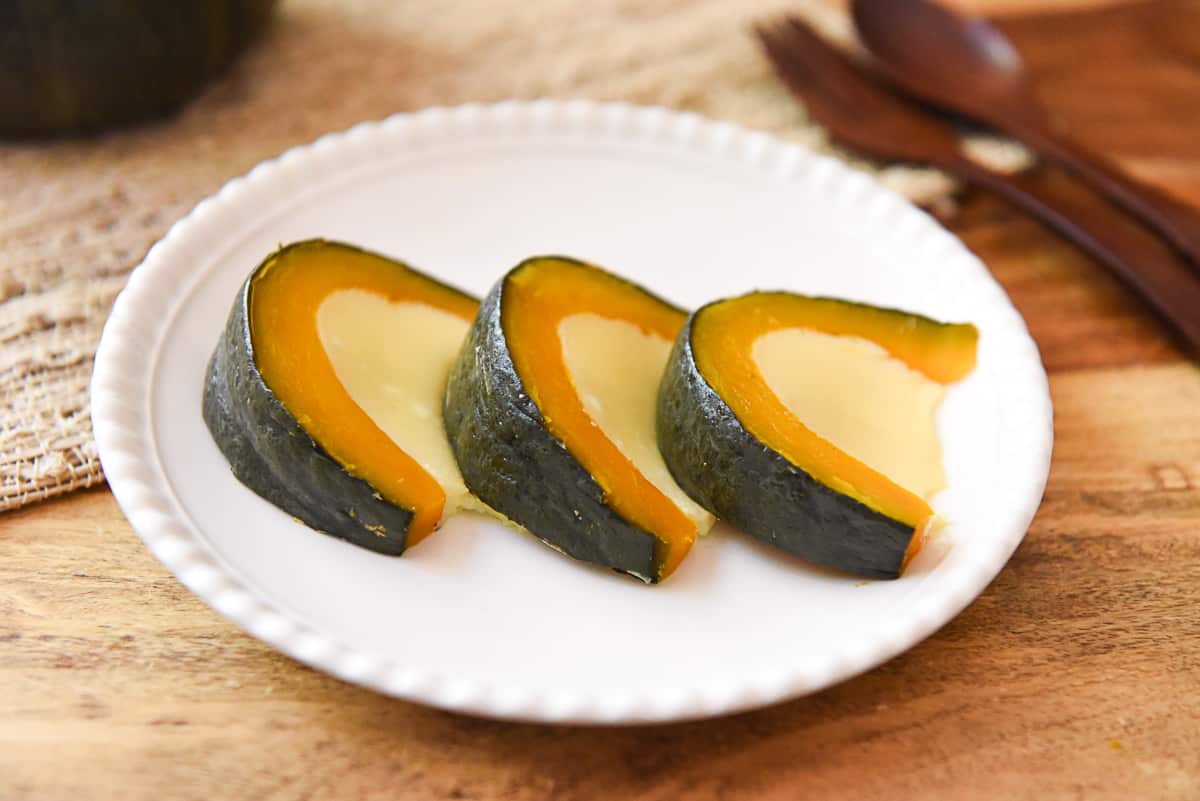
Recipe

Thai Pumpkin Custard | Sankaya Faktong | สังขยาฟักทอง
Ingredients
- 1 small kabocha squash
- 4 eggs
- ¾ cup coconut milk
- ½ cup palm sugar
- ¼ teaspoon salt
- 1 teaspoon vanilla extract
Instructions
- Prepare the Pumpkin: Wash your pumpkin thoroughly. Cut a circular opening in the top. It may help to use a glass or small bowl to mark the circle and then use a very sharp knife to cut it out. Scoop out all of the pumpkin insides and rinse to ensure it's clean and smooth inside. Turn the pumpkin upside down on a towel to drip dry.
- Make the Custard: Mix the palm sugar, coconut milk, salt, and vanilla extract over medium heat until the palm sugar dissolves. Take off the heat and cool back to room temperature. Add your eggs to the the coconut milk mixture and mix well to form the custard.
- Pour Custard into Pumpkin: Pour the custard into your hollowed out pumpkin, just to the bottom of the circular opening. If there is leftover custard, see Note below.
- Steam the Pumpkin Custard: Add water to the bottom of a steamer pot and heat on medium high. Place the pumpkin filled with custard in the top of the steamer. Leave the pumpkin open at the top. If you would like to steam the pumpkin top, set it next to the pumpkin in the steamer pot. Let the pumpkin steam for 45 minutes untouched. Once it's done, allow to cool completely. If the custard overflowed the pumpkin, just skim the top off. Then slice into individual pieces and enjoy!
Video



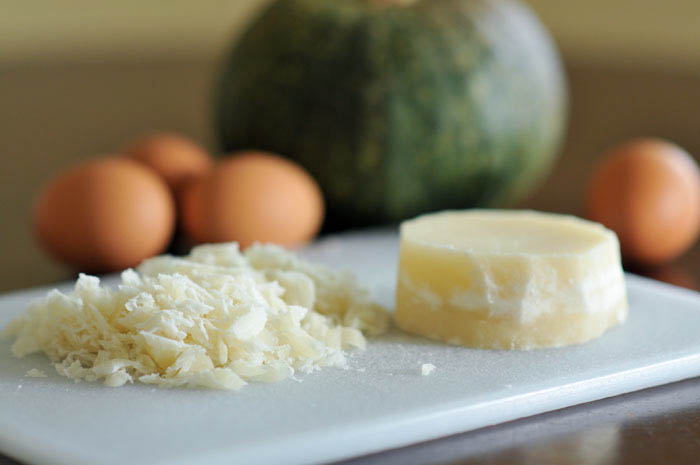
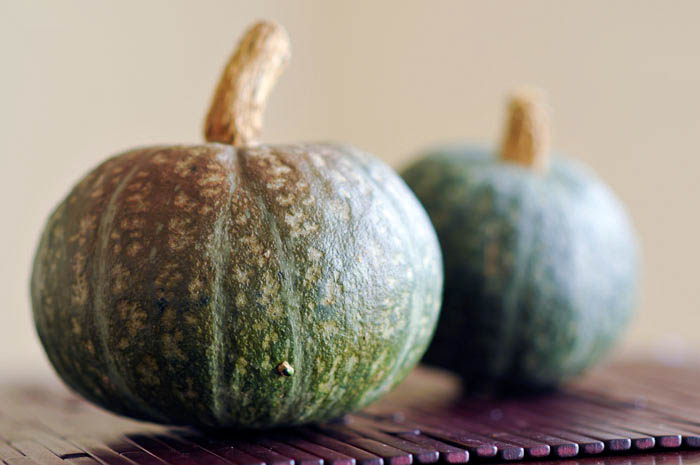




Janjira Williams
The instructions was clear and easy to follow.
K
It's a little tricky to make but definitely fun to try! I have never tried this dish before so I'm not sure how it's supposed to taste, but the custard definitely had a very mild flavor and was subtly sweet. I wouldn't mind if it had more flavor. I picked the smallest kabocha squash I could find and the amount of custard was PERFECT. After steaming for 45 minutes, it didn't seem set yet because the thermometer came out with wet custard on it (and I don't think my thermometer works because it says it was only 140 degrees), so I steamed it another 10 minutes. Although the custard was perfectly set with the additional time, the pumpkin split in a few places. I think the pumpkin was overcooked because it completely fell apart when I took it out of the pot, although the custard kept its shape beautifully! Drizzled with maple syrup for flavor and sweetness but it was still a bit bland to me, but maybe that's just my American preference for overly sweet things!
maarten
hello making it now ,,
what i found using an 8 inch pumpkin that i'm short on custard.
so had to make a bit more.
used cane sugar instead ( my palm sgar gone bad, so much i use that stuff)
now the custard seems a bit dark in color
hope it will end up a bit lighter
greets
from Thailand
Maarten
Andrew
My custard won't set and I'm not sure why
Rachel
Sorry to hear that Andrew... Let me know if you'd like help troubleshooting it.
mike
Well, I just finished eating my custard over the last few days...here's the report:
pulling the pumpkin when the internal custard temp reached 75C (170F). was perfect. it was firm but not overcooked and sliced very nicely. Keep in mind, I cooled my pumpkin all the way to room temp before slicing. I'm not sure it would have been as firm while still warm. just a thought. If I were going to serve it warm, I'd probably consider going to 174 or 175, but no higher as residual heat from the pumpkin will keep the temp rising a few more degrees.
My version of your recipe was:
An 8" diameter japanese pumpkin - very close to the kubocha squash you use in the USA
4 duck eggs (probably liquid equivalent to at least 5 chicken eggs)
250ml (1 cup) Chao Koh coconut milk. I used the higher fat version 180kcal per serving. I've learned to check labels as there's different 'strengths' out there
130g (5oz weight) palm sugar - I will probably go to 150g (almost 6 oz)next time
1/4tsp salt
then followed your instructions with the notes below added
After I gutted and cleaned my pumpkin, I rinsed it out thoroughly and allowed to drip dry for about an hour. I heard somewhere that doing so helps ensure the custard sticks inside. You didn't mention having any issues, so it's probably an old wives' tale. But my custard did adhere nicely to the pumpkin allowing for really pretty slices.
I used 4 stalks of pandanus leaves and food processed them with the coconut milk, then strained twice through a fine strainer before using the coconut milk. Frankly, I'd either double the pandanus leaves or leave them out all together (and go with the vanilla). 4 leaves just didn't do enough. The taste/smell was just lost in all the other flavors.
I also strained my raw custard through a fine strainer as duck eggs often leave egg white clumps no matter how hard you beat them. Frankly, it helps ensure a smoother custard in general, so I'd probably do it with chicken eggs too (a habit I acquired when I was making loads of homemade ice cream)
It was creamy, smooth, just sweet enough while the pumpkin added a nice counterpoint in every spoonful, My brother prefers things sweeter than me, so we just laid some sweetened thick coconut cream over his slice (in a way, sort of a Thai whipped cream)
So again, thanks for getting me motivated to take on a dessert I've loved since childhood. I was really easy and REALLY delicious
Rachel
Hi Mike, Thanks for such a detailed report! I'm happy to have these notes, and I'm sure others trying to make this pumpkin custard will be too! We might need to collaborate on some recipe testing in the future 🙂
mike
this is an old thread but I'm making this today (in Thailand). My pumpkin is cooling down as I write this and it looks great. I have a question though...do you have an internal temperature reading for the custard when it's done? I'm an engineer by trade and prefer to 'cook by the numbers', when possible. As my dish was steaming, I started looking for general guidelines and have gotten the following: the eggs in the custard begin solidifying at about 68-70 Celsius (just under 160F) and shouldn't exceed 80 or 82 C (about 175 or so). The eggs will sort of curdle and your custard will get pretty 'eggy' tasting if they do. I know this from making ice cream using a cooked custard base. I've taken mine out at 75C. It looks solid enough but I won't know until I slice it.
Lastly, what recipe doesn't get tinkered with? And in my case, I used duck eggs as they're readily available and are richer than chicken eggs. I also substituted pandanus leaves (infused them into the coconut milk) for vanilla. I suppose it's more authentic - but then again, I'm here in Thailand where vanilla is the more exotic condiment. Also vanilla is not something I keep in my kitchen here.
I'll let you know the results of the taste test
thanks for inspiring me to actually do this dessert
Rachel
Duck eggs and pandan leaves sound like perfect substitutions! I'm also curious about the internal temperature of the custard... Let me know how it turns out.
amy
will the pumpkin still taste fresh if i make it the night before? what do i do with leftover pumpkin can i refrigerator it?
Rachel
Hi Amy, yes, the pumpkin should still taste pretty good if made ahead of time and refrigerated. I tend to snack on this dessert for days after making it 🙂
Kay
Hi Rachel,
I steamed this recipe a couple of nights ago using honey instead of palm sugar (what we had on hand) and it turned out great except-- the custard didn't cook nearly as fast as the pumpkin did. Granted, I was using a makeshift steamer, but the one detail I haven't been able to figure out, is whether or not the top of the pumpkin is left off or on during the steaming process? Mine was left on, and I feel like it may have contributed to a not-done custard when the squash was cooked through.
Ideas?
Best wishes,
~Kay
Rachel
Hi Kay,
I usually steam my pumpkin with the top off, and just placed to the side of the pumpkin in the steamer. I wonder if the consistency of the honey versus palm sugar could have also contributed to the custard taking longer to cook?
Best,
Rachel
Robyn
Hi Rachel - In New Zealand I don't think we can buy blocks of palm sugar. Can granulated sugar be used? If so, what kind? There is a wide range of sugar from white, brown, raw, muscovado, demerera. Look forward to trying some of your recipes, especially the grilled bananas!
Robyn
Rachel
Hi Robyn, I've seen brown sugar used as a substitute for palm sugar, but haven't tried it in these recipes. Best of luck!
Rachel
Hi Joli - I'm a fan of just about anything stewed in coconut milk 🙂 Kabocha pumpkin pie sounds fantastic!
Rachel
Thanks, Jonathan! Glad you guys liked it!
Joli
This looks great! I love thai food! Have you tried Kabocha stewed in coconut milk? Decidedly not good for you and oh so delicious! Tasty at breakfast over some kasha 😉
I'll be making a Gluten free Kobucha pumpkin pie for thanksgiving this year! I can't wait. Combining cultures is fun.
JonathanN
Great recipe ! I made it for my wife! It`s delicious!!! Thanks for sharing!
Melanie
I am drooling over this wonderful-looking dessert!! I am totally a supporter of your love for all things pumpkin, and I agree, Thanksgiving is the perfect opportunity to indulge that affair 🙂 Here in Japan, they also use kabocha, but luckily I found a can of pumpkin puree so I can make my beloved pumpkin pie! I will definitely stay tuned here for more delicious Thai recipes!